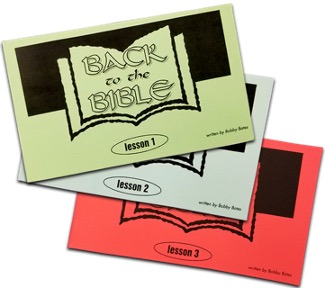Occasionally, someone will say that Christians should not use written Bible studies such as Back to the Bible to teach the gospel to sinners. “Just use the Bible” is their mantra.
Luke 24:27 records Jesus conducting a Bible study, using the “back to the Bible” approach. He started with Moses and then moved through the prophets showing that He was the Christ. What if someone listening that day had written down the Scriptures Jesus used and what He said in tying them together? Surely, if we had been there, this would have been a wise thing to do. What if the person then put those Scriptures and teaching points into a booklet, called it Back to the Bible or Jesus’ Teaching Approach, and shared it with others as a way to teach the gospel? Would that be wrong? Far from it. It would be wise.
Using a Bible study method is not in violation of solo scriptura (only Scripture) or speaking only where the Bible speaks (1 Peter 4:11). It is not adding to the Bible (Revelation 22:18-19). Bible study curriculum like Back to the Bible uses the pertinent Scriptures to focus the student on Christ and His plan of salvation. Taking students to the Bible is the only strategy that harmonizes with biblical teaching. Like a concordance or Bible dictionary, Bible study question sheets would be useless without the Bible since they require an open Bible for the answers. Such teaching is nothing without the Bible, but with it, it is the power of God to save.
Jesus did not tell Christians to send Bibles all over the world to save souls. People all over the world read Bibles, yet many are never converted. Like the Ethiopian, they need someone to explain the Bible to them (Acts 8:31). When Jesus sent His disciples out, He told them to teach and preach and teach some more (Matthew 28:19-20; Mark 16:15). By definition, teaching involves explaining and expounding upon the Scriptures (Acts 2:40-41). Teaching uses a combination of inspired Scripture and uninspired words. To say otherwise is to say that any preacher who does anything other than quote Scripture in a sermon is adding to the Bible. That is foolish.
On the day of Pentecost, Peter did not read all the books of the prophets to the audience. He pulled verses from Joel and the Psalms to point his hearers to Christ and His church (Acts 2). He did not quote verse after verse without explaining what these verses meant to the occasion. Stephen did not tell his accusers to go read the entire book of Exodus. He pulled verses from it that were needed to teach his audience about redemption (Acts 7). Paul did not quote all of 1 and 2 Samuel or Isaiah, but he selected verses to reveal Jesus as the Christ (Acts 13).
Bible studies can be conducted by the spoken word, in written form, or by a combination of the two. The eye and the ear are better learners than either one alone. In the big picture, written material preserves teaching for future generations. It is also the chosen method of God—thus the Bible!
Straining at a gnat is another way Satan is hindering the church from getting the gospel to those who are quickly heading to Judgment Day unprepared.
–Rob Whitacre and Allen Webster


Recent Comments